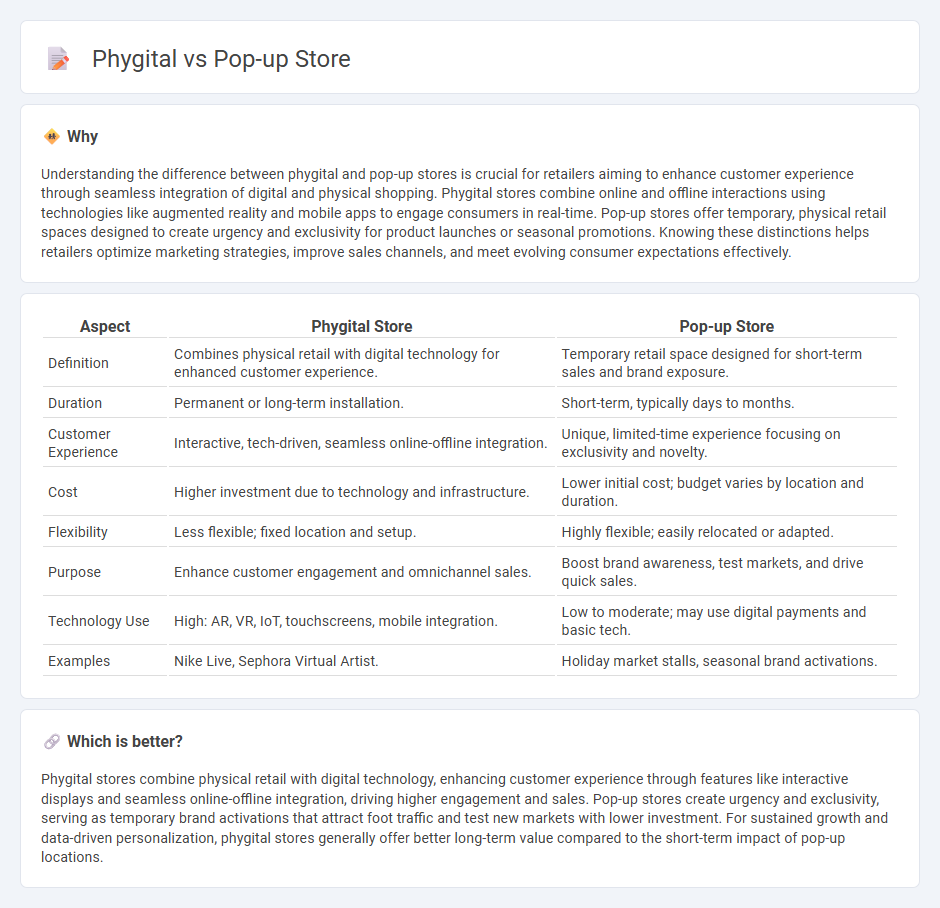
Phygital retail seamlessly blends physical and digital shopping experiences, leveraging technologies like augmented reality and mobile apps to enhance customer engagement. Pop-up stores offer temporary, immersive brand experiences in physical locations, creating urgency and exclusivity while testing new markets or products. Explore how these innovative retail strategies can drive customer interaction and boost sales performance.
Why it is important
Understanding the difference between phygital and pop-up stores is crucial for retailers aiming to enhance customer experience through seamless integration of digital and physical shopping. Phygital stores combine online and offline interactions using technologies like augmented reality and mobile apps to engage consumers in real-time. Pop-up stores offer temporary, physical retail spaces designed to create urgency and exclusivity for product launches or seasonal promotions. Knowing these distinctions helps retailers optimize marketing strategies, improve sales channels, and meet evolving consumer expectations effectively.
Comparison Table
| Aspect | Phygital Store | Pop-up Store |
|---|---|---|
| Definition | Combines physical retail with digital technology for enhanced customer experience. | Temporary retail space designed for short-term sales and brand exposure. |
| Duration | Permanent or long-term installation. | Short-term, typically days to months. |
| Customer Experience | Interactive, tech-driven, seamless online-offline integration. | Unique, limited-time experience focusing on exclusivity and novelty. |
| Cost | Higher investment due to technology and infrastructure. | Lower initial cost; budget varies by location and duration. |
| Flexibility | Less flexible; fixed location and setup. | Highly flexible; easily relocated or adapted. |
| Purpose | Enhance customer engagement and omnichannel sales. | Boost brand awareness, test markets, and drive quick sales. |
| Technology Use | High: AR, VR, IoT, touchscreens, mobile integration. | Low to moderate; may use digital payments and basic tech. |
| Examples | Nike Live, Sephora Virtual Artist. | Holiday market stalls, seasonal brand activations. |
Which is better?
Phygital stores combine physical retail with digital technology, enhancing customer experience through features like interactive displays and seamless online-offline integration, driving higher engagement and sales. Pop-up stores create urgency and exclusivity, serving as temporary brand activations that attract foot traffic and test new markets with lower investment. For sustained growth and data-driven personalization, phygital stores generally offer better long-term value compared to the short-term impact of pop-up locations.
Connection
Phygital retail seamlessly integrates digital technology with physical shopping experiences, enhancing customer engagement through interactive displays and personalized services. Pop-up stores utilize phygital elements by combining transient physical spaces with digital touchpoints such as QR codes, augmented reality, and mobile apps to attract tech-savvy consumers. This fusion boosts brand awareness and drives sales by creating immersive, data-driven shopping environments tailored to evolving consumer behavior.
Key Terms
Temporary Location (Pop-up Store)
Pop-up stores serve as temporary retail locations designed to create unique, immersive brand experiences that drive immediate consumer engagement and sales. These stores capitalize on exclusivity and urgency by appearing in high-traffic areas for limited durations, offering opportunities for real-time customer feedback and market testing. Explore how leveraging pop-up stores can amplify your brand's presence and boost consumer interaction.
Omnichannel Integration (Phygital)
Phygital retail seamlessly integrates physical and digital experiences, enhancing omnichannel strategies by enabling consistent customer engagement across in-store and online platforms. Pop-up stores offer temporary, localized brand experiences but lack the long-term omnichannel integration benefits found in phygital models, which leverage technology to create unified shopping journeys. Discover how phygital approaches optimize customer retention and streamline omnichannel integration for modern retailers.
Experiential Retail
Pop-up stores create immersive, limited-time shopping experiences that drive consumer engagement through physical interaction and exclusivity, enhancing brand awareness and urgency. Phygital retail merges physical and digital elements by integrating technology such as AR, QR codes, and interactive displays to offer seamless, personalized experiences that bridge online and offline shopping. Explore innovative strategies in experiential retail to transform customer journeys and boost brand loyalty.
Source and External Links
What is a pop-up shop? Benefits, types, and how to start - Printify - A pop-up shop is a temporary retail experience, either in person or online, designed to sell products or services for a short period, creating excitement and customer engagement without the costs of a permanent store.
Introducing Printify Pop-Up Store - Printify's Pop-Up Store is an easy, fee-free way for sellers to launch customizable online stores quickly, offering personalized products with no subscription fees and handling printing and shipping for you.
What is a pop-up shop? | Definition, history, benefits, costs | Storefront - Pop-up shops are deliberately temporary stores established to engage customers uniquely and flexibly, often moving locations and gaining popularity for challenging traditional retail by reducing risk and lease commitments.
 dowidth.com
dowidth.com